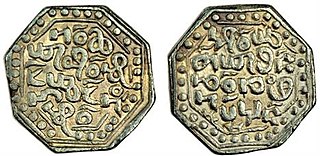| |||||
| Centuries: | |||||
|---|---|---|---|---|---|
| Decades: | |||||
| See also: | List of years in India Timeline of Indian history | ||||
Events from the year 1539 in India.
| |||||
| Centuries: | |||||
|---|---|---|---|---|---|
| Decades: | |||||
| See also: | List of years in India Timeline of Indian history | ||||
Events from the year 1539 in India.
| | This section is empty. You can help by adding to it. (October 2012) |

The Ahom dynasty (1228–1826) ruled the Ahom Kingdom in present-day Assam, India for nearly 598 years. The dynasty was established by Sukaphaa, a Shan prince of Mong Mao who came to Assam after crossing the Patkai mountains. The rule of this dynasty ended with the Burmese invasion of Assam and the subsequent annexation by the British East India Company following the Treaty of Yandabo in 1826.

The Dimasa Kingdom was a late medieval/early modern kingdom in Assam, Northeast India ruled by Dimasa kings. The Dimasa kingdom and others that developed in the wake of the Kamarupa kingdom were examples of new states that emerged from indigenous communities in medieval Assam as a result of socio-political transformations in these communities. The British finally annexed the kingdom: the plains in 1832 and the hills in 1834. This kingdom gave its name to undivided Cachar district of colonial Assam. And after independence the undivided Cachar district was split into three districts in Assam: Dima Hasao district, Cachar district, Hailakandi district. The Ahom Buranjis called this kingdom Timisa.

Suhungmung, or Dihingia Roja I was one of the most prominent Ahom Kings who ruled at the cusp of Assam's medieval history. His reign broke from the early Ahom rule and established a multi-ethnic polity in his kingdom. Under him the Ahom Kingdom expanded greatly for the first time since Sukaphaa, at the cost of the Chutia and the Dimasa kingdoms. He also successfully defended his kingdom against Muslim invasions, first by a general called Bar Ujjir and another by Turbak Khan. During his time, the Khen dynasty collapsed and the Koch dynasty ascended in the Kamata kingdom. His general, Ton-kham, pursued the Muslims up to the Karatoya river, the western boundary of the erstwhile Kamarupa Kingdom, the farthest west an Ahom military force had ventured in its entire six hundred years of rule.

The Ahom kingdom was a late medieval kingdom in the Brahmaputra Valley that retained its independence for nearly 600 years despite encountering Mughal expansion in Northeast India. Established by Sukaphaa, a Tai prince from Mong Mao, it began as a mong in the upper reaches of the Brahmaputra based on wet rice agriculture. It expanded suddenly under Suhungmung in the 16th century and became multi-ethnic in character, casting a profound effect on the political and social life of the entire Brahmaputra valley. The kingdom became weaker with the rise of the Moamoria rebellion, and subsequently fell to repeated Burmese invasions of Assam. With the defeat of the Burmese after the First Anglo-Burmese War and the Treaty of Yandabo in 1826, control of the kingdom passed into East India Company hands.
Supaatpha also, Gadadhar Singha, established the rule of the Tungkhungia clan of the Ahom kings that ruled the Ahom kingdom till its climactic end. He was the son of Gobar Roja, a descendant of Suhungmung, and who had become the king for a mere 20 days. Previously known as Godapani, Supatphaa was able to stabilize the kingdom after the decade-long turmoil following the Ahom victory in the Battle of Saraighat. This period saw the ruthless power grab of Debera Borbarua and Laluksola Borphukan's abandonment of Guwahati and oppression via Sulikphaa Lora Roja. Supatphaa retook Guwahati from the Mughals for good, and established a strong rule of 'blood and iron'. He came into conflict with the Moamoria Vaishnava sattra which belonged to the folds of Kal "songhoti"and made way for Rudra Singha, his son and succeeding king, to take the kingdom to its zenith.
Bakata was the capital of the Ahom kingdom established by the Ahom king Suhungmung (1497–1539) in the 16th-century. Since his capital was by the Dihing river, Suhungmung is also known as the Dihingia Raja. The next king, Suklenmung (1539–1552), moved the capital to Garhgaon. The place is recorded in the Chinese chronicle Ming Shilu and is referred to as Bajiata. Before it became the Ahom capital in the early 16th century, the Ming Shilu describes it as a polity subordinate to Da Gu-la, an unidentified polity located somewhere in modern-day Northern Burma or Assam.
Borpatragohain was the third of the three great Gohains (counsellors) in the Ahom kingdom. This position was created by Suhungmung Dihingia Raja in the year 1527 when Konsheng was made the first Borpatrogohain. The designation was borrowed from Vrihat-patra, the Habung dependent of the Chutiya king.

Habung is a historical region in present-day Lakhimpur district of Assam, India, although some Tai-ahom activists claim it to be a part of present-day Dhemaji district. As per epigrahic records, Habung (Ha-vrnga-Vishaya) was a vishaya or province where Brahmins were settled by Ratna Pala of the Pala dynasty of Kamarupa in the 10th century.

Suklamphaa also Ramadhwaj Singha was a king of the Ahom kingdom. His reign is known for the rise in power of Debera Borbarua and the beginning of a ten-year period of power struggles among high officials of the kingdom that saw quick changes in kings via court intrigues and internal armed conflicts.

The Chutia Kingdom was a late medieval state that developed around Sadiya in present Assam and adjoining areas in Arunachal Pradesh. It extended over almost the entire region of present districts of Lakhimpur, Dhemaji, Tinsukia, and some parts of Dibrugarh in Assam, as well as the plains and foothills of Arunachal Pradesh. The kingdom fell in 1523–1524 to the Ahom Kingdom after a series of conflicts and the capital area ruled by the Chutia rulers became the administrative domain of the office of Sadia Khowa Gohain of the Ahom kingdom.

Me-Dam-Me-Phi is the most important veneration of the dead communal festival in the Ahom religion celebrated by the Ahom people on 31 January every year in memory of the departed. It is the manifestation of the concept of ancestor worship that the Ahoms share with other peoples originating from the Tai stock. It is a festival to show respect to the departed ancestors and remember their contribution to society.
Hazarika was a Paik officer under the administration of the Ahom kingdom and Koch kingdom. The commander over 1,000 (Hazar) paiks was known as a Hazarika. As it was a purely administrative position, the title holder could belong to diverse ethnic groups.

Suklenmung(1539–1552) was a king of the Ahom kingdom in medieval Assam. Since he established his capital at Garhgaon, he is also called the Garhgaiya roja in the Buranjis. It was during his reign that Madhabdev and Sankardeva's son-in-law Hari were captured and Hari executed, which precipitated the departure of Sankardeva from the Ahom kingdom.
Saikia was a Paik officer of the Ahom militia who led a hundred paiks. There was a similar office in the Koch kingdom as well. As it was a purely administrative position, the title holder could belong to diverse ethnic groups. Today, this title is used as a surname by people of various ethnic origins. It is found among Kaibarta community. The Saikia in the Paik system was higher in rank to the Bora but lower in rank to the Hazarika.

Supimphaa was the king of Ahom kingdom from 1493 CE to 1497 CE. In order to exact revenge on the murderers of his father Suhenphaa, he unleashed a reign of terror among people of both high and low ranks alike.

Sukhrangpha or Tao Shukhampha was the king of Ahom kingdom from 1332 CE to 1364 CE. He had to face the revolt led by his youngest brother Chao Pulai or Tai Sulai (there are confusion in Ahom historians whether Chao Pulai and Tai Sulai were same or different personality. Eventually he came in terms with Chao Pulai by appointing him as Charing Raja, a newly created official post to administer the region of Charing. Later the post of Charing Raja was usually conferred to the heir apparent to the throne. It can be compared with the title of Prince of Wales of England, where the heir apparent to the throne was conferred with this title.

Sunyatphaa also Udayaditya Singha was the king of Ahom Kingdom from 1670 CE to 1672 CE. After his elder brother Swargadeo Chakradhwaj Singha died in the middle of Ahom-Mughal war, Udayaditya Singha succeeded to the throne. His reign witnessed the end of Ahom-Mughal war, which started during the reign of Chakradhwaj Singha, when the Mughal army led by Rajput prince, Ram Singh I of Amber, was decisively defeated by the Ahom forces led by Ahom commander Lachit Borphukan in the Battle of Saraighat. The later part of his reign was characterized by the failure of military expedition against the Dafala tribes and the influence of Paramananda Sannyasi, a saintly figure from Brindaban, over Udayaditya Singha. Udayaditya's over exerted devotion towards Paramananda Sanyasi, aroused dissatisfaction among the nobles, which ultimately caused his deposition and execution. His reign was followed by a series of political anarchy and internal disturbances in the Ahom kingdom which continued till the accession of Gadadhar Singha in 1681 CE.
Events from the year 1552 in India.
The Koch–Ahom relations (1532–1571) refer to the diplomatic, strategic and military relationships between the Koch and the Ahom kingdoms over the control of the Brahmaputra Valley. Though an initial contact between the Ahoms and Koch occurred during Biswa Singha's reign, the relationship became belligerent with Nara Narayana ascending to power and consolidating his hold over the western portion of Assam; and it ended with the failure of Chilarai's campaign against Sulaiman Karrani. This was followed by an alliance that soon gave way to a fierce conflict between the Ahoms and the Mughals.

Ahomisation was an assimilation process in the former Ahom kingdom of Assam by which the people from different ethnic groups in the region became a part of what is now considered as the Ahom population.